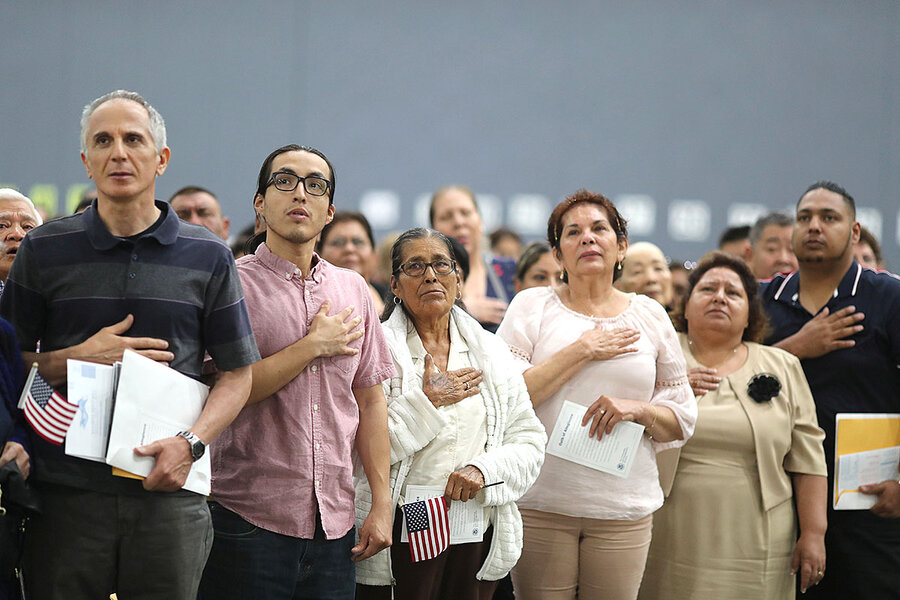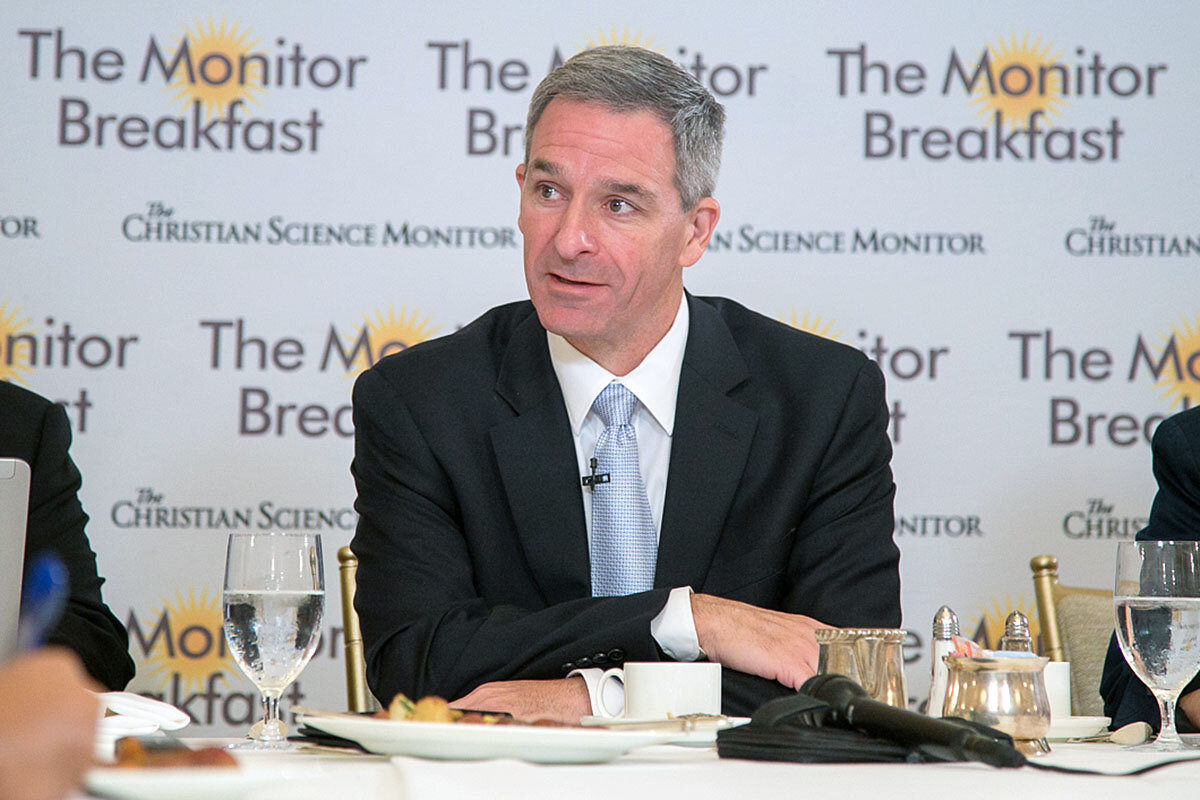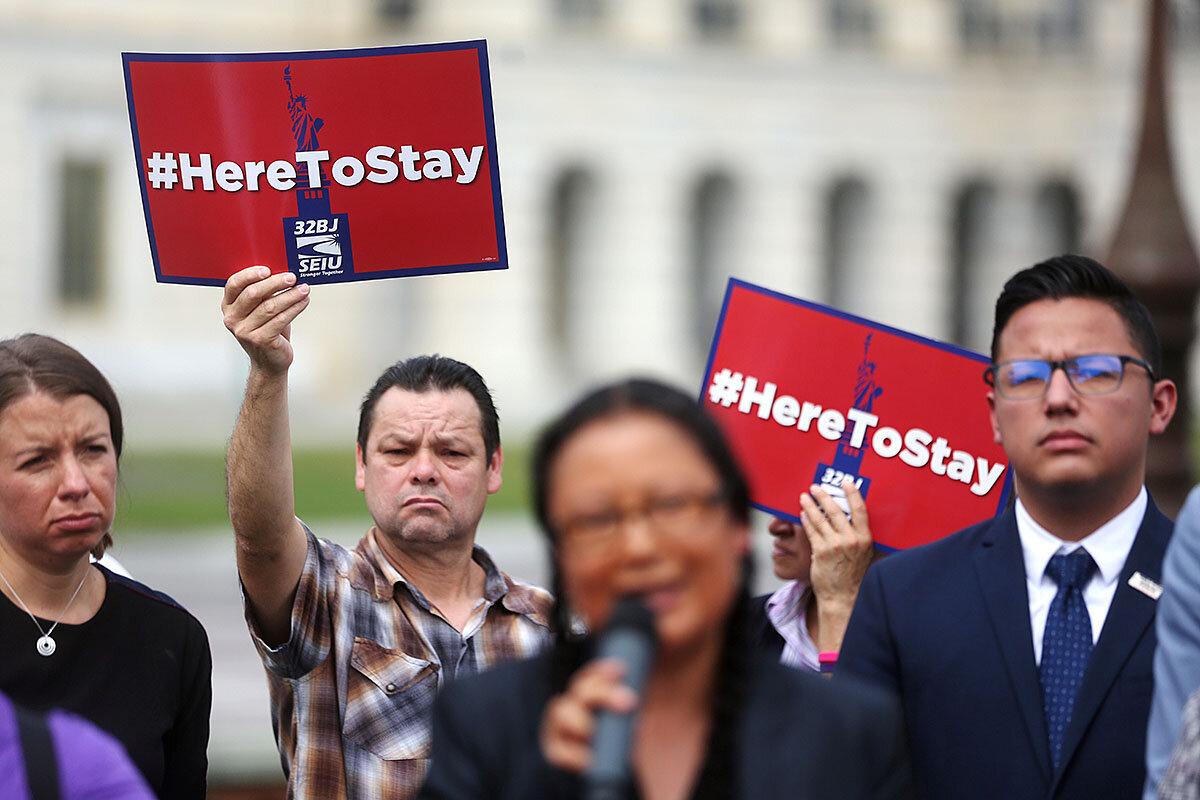Trump policy stirs debate: How 'self-sufficient' must immigrants be?
Loading...
| Washington
President Donald Trump’s recasting of United States immigration policy isn’t just about letting fewer newcomers into the country. It’s also about redefining who is worthy to enter.
His administration’s stated criterion: those who are self-sufficient.
To the president’s supporters, it’s common sense. Favoring the skilled can boost the U.S. economy. And favoring the industrious will reduce a rising taxpayer tab for federal safety-net programs. Nations like Australia and Canada have already gone down this path toward a merit-based system for immigrant visas, they say.
Why We Wrote This
A core divide in political values is becoming central to the heated debate over immigration. Conservatives espouse the ideal of self-sufficiency, while liberals embrace interdependence.
“The president has made no secret of the fact that he believes the American immigration system, first and foremost, is set up to work for America. That means economically and for the people [already] here,” Ken Cuccinelli, the acting director of U.S. Citizenship and Immigration Services, told reporters Wednesday at a Monitor Breakfast.
It’s an objective that resonates with voters like Tammy Waddell, who has a horse farm about an hour’s drive north of the nation’s capital and who calls the nation’s current immigration situation “out of control.”
But this ideal of self-sufficiency might not be so simple to put into practice. For one thing, it’s not easy to draw bright lines between “desirable” and “undesirable” immigrants.
Mr. Trump’s policies are reducing the number of available workers in an already tight job market. Across America, many help-wanted ads are for low-skilled jobs, not for the college graduates favored by the president. A rule finalized recently by Mr. Cuccinelli could sharply limit the pool of immigrants available for low-wage work. It seeks to block green cards to people deemed likely to enroll in federal welfare programs.
“It’s a very misleading definition of self-sufficiency,” says Elizabeth Lower-Basch, an expert on income and benefits at the Center for Law and Social Policy in Washington. “The vast majority of working-age adults who receive Medicaid [or food assistance] are in fact working.”
The ‘economic value’ of immigrants
The new restrictions, based on whether someone is likely to become a “public charge,” build on federal laws and guidelines going back as far as 1882. The Trump administration has created a more detailed and restrictive rule tied to U.S. law. Last week, judges in several federal courts blocked it from going into effect.
Critics say the rule would amount to revising the land-of-opportunity ideal embodied at the base of the Statue of Liberty, where the famous words of poet Emma Lazarus say: “Give me your tired, your poor, your huddled masses yearning to breathe free.”
Backers of the policy, including Mr. Cuccinelli, defend a heightened focus on the “economic value” of immigrants. And he notes that the new criteria are aimed at family or employment immigrants, not those who seek access to the U.S. on a humanitarian basis as refugees or asylees.
“We continue to provide … the most long-term permanent relief in the world. So our position as the No. 1 most generous country in the world is not at any risk,” he asserted at the Monitor Breakfast. Still, Mr. Cuccinelli also discussed Trump administration plans to roll back the volume of entrants in those humanitarian categories.
What does the economy need?
Some economic-policy experts argue that curtailing the number of immigrants – and screening them in ways that narrow ethnic and socioeconomic diversity – could backfire economically. The current demand is for low-skill workers and the outsize contributions that immigrants make to the formation of new businesses.
“We have an economy that is full of jobs that fill vital needs but are not paying very well and often do not provide health insurance,” says Ms. Lower-Basch. “And so people get these supports from the government to supplement their work. Whereas ‘public charge’ was really written about people who ... were going to entirely rely on the government and not support themselves at all.”
Recent Trump actions seek to screen out applicants who can’t show they’ll be able to buy health insurance – putting up a major obstacle for many would-be immigrants.
That could be a problem for the economy, say some employers, who complain of a shortage of workers in general or who say not all skilled immigrants come with money and college degrees in hand.
The U.S. Chamber of Commerce supports programs to attract both high- and low-skill immigrants. In a recent blog post it cited an “ominous” decline in the number of people coming from overseas to study at U.S. universities – often a path toward employment. “Concerns about our nation’s immigration system” were viewed by many as a key reason.
Many economists say immigrants pay taxes that outweigh the public benefits they receive, contribute to innovation in ways that can be stunted by policies that restrict their diversity, and don’t erode opportunities for native-born residents.
Still, public opinion remains sharply divided, at a time when immigrants account for nearly 14% of the U.S. population, not far from prior-century peaks seen around 1910.
Maryland shows the variety views
In rural Frederick County, in Maryland, the county sheriff is seeking to collaborate with federal officials against unauthorized immigrants. Residents have formed opposing camps over whether the need is to combat racism and xenophobia or to uphold the rule of law.
To Ms. Wadell, the principle of self-sufficiency goes hand-in-hand with limiting immigration to those who apply and are accepted through legal channels.
“Be legal and work, and I don’t have a problem,” she says, as she and her husband fill their truck with gas before heading home to care for their horses. In her view, many immigrants rely on welfare programs at the expense of taxpayers.”
In the city of Frederick, not far from the Pennsylvania border, some see it differently.
“It’s a huge myth that immigrants are coming here to get public assistance,” says Michael Haverty, who works at a music and arts shop. “It’s also a big myth that … you stay on public assistance forever.”
For him, a reference point is his own family heritage. “My ancestors came here in the 1840s from Ireland in our darkest chapter,” Mr. Haverty says. They worked their way from poverty into mainstream U.S. life, he says, as immigrants have been doing ever since.
A few storefronts down, Jorge Ovando is adjusting an umbrella and cleaning a table outside a Peruvian restaurant. He is on a visa from Peru, aiming to earn money for a business degree and to polish his English language skills.
Mr. Ovando notes that his own job was created by a fellow Peruvian who started at a bottom-level restaurant job and worked his way up to a supervisory job and then opening this small cafe.
The question of self-sufficiency
But some experts say there’s good logic behind the Trump administration’s heightened focus on self-sufficiency.
“In welfare policy in general, one of the touchstones of the Trump administration has been to expect more individuals to work or participate in constructive activities,” says Matt Weidinger, a poverty expert at the American Enterprise Institute in Washington.
The Trump administration’s attempted shift toward a more merit-based system “is not a question of who is intrinsically a better human being,” says Mark Krikorian, executive director of the Center for Immigration Studies, which advocates for less immigration. “We want immigrants that we expect to be able to thrive – and in a modern post-industrial knowledge-based economy, that means having a certain level of education and arriving with a certain knowledge of English.”
The Trump administration’s goal is not only to enforce the new criteria. It also wants to emphasize employment more (and family ties less) in selecting legal immigrants.
But one question is whether that overlooks the value of interdependence. In the current economy, many people contribute as workers even while receiving some public support.
For example, the public charge rule, if it passes muster in court, would mean that “legal immigrants with disabilities will be unable to apply for and receive needed services to find and maintain employment,” Stacy Cervenka of the American Foundation for the Blind wrote recently. She calls that “entirely contradictory to DHS’s professed intention to ensure that immigrants are self-sufficient.”
As divisive as the issues are, many on both sides of the political spectrum say America’s immigration challenges ultimately will require bipartisan legislative answers. Mr. Cuccinelli said “there’s only so much we’re going to do by regulation and rule without Congress’s participation.”
Mark Greenberg, an expert at the Migration Policy Institute, takes the point a step further. “There’s a strong argument,” he says in an email, “that if there’s going to be a major shift in policy about who gets admitted to the country, that decision ought to be made by Congress – not by giving immigration officials broad discretion to implement a complex test without safeguards to prevent arbitrariness.”
Staff writer Sarah Matusek contributed to this report from Boston.
Editor's note: One sentence has been updated to remove a reference to the coming vacancy in the role of acting secretary of Homeland Security.








